A Cleanable Self-Assembled Nano-SiO2/(PTFE/PEI)n/PPS Composite Filter Medium for High-Efficiency Fine Particulate Filtration
Abstract
:1. Introduction
2. Materials and Methods
2.1. Materials
2.2. Preparation of the SiO2 Nanoparticle Dispersion
2.3. Preparation of the SiO2/(PTFE/PEI)n/PPS Composite Filter Medium
2.4. Characterizations
2.5. Dynamic Filtration Properties
3. Results and Discussion
3.1. Physical Properties of the Filter Media
3.2. Structural Characterizations of the Filter Media
3.3. Dynamic Filtration Characterization of the SiO2/(PTFE/PEI)10/PPS Composite Filter Medium
4. Conclusions
Supplementary Materials
Author Contributions
Funding
Institutional Review Board Statement
Informed Consent Statement
Data Availability Statement
Conflicts of Interest
References
- Cohen, A.J.; Brauer, M.; Burnett, R.; Anderson, H.R.; Frostad, J.; Estep, K.; Balakrishnan, K.; Brunekreef, B.; Dandona, L.; Dandona, R.; et al. Estimates and 25-year trends of the global burden of disease attributable to ambient air pollution: An analysis of data from the Global Burden of Diseases Study 2015. Lancet 2017, 389, 1907–1918. [Google Scholar] [CrossRef] [Green Version]
- Burnett, R.K.; Chen, H.; Szyszkowicz, M.; Fann, N.; Hubbell, B.; Pope, C.A.; Apte, J.S.; Brauer, M.; Cohen, A.; Weichenthal, S.; et al. Global estimates of mortality associated with long-term exposure to outdoor fine particulate matter. Proc. Natl. Acad. Sci. USA 2018, 115, 9592–9597. [Google Scholar] [CrossRef] [PubMed] [Green Version]
- Geng, G.; Xiao, Q.; Liu, S.; Liu, X.; Cheng, J.; Zheng, Y.; Xue, T.; Tong, D.; Zheng, B.; Peng, Y.; et al. Tracking air pollution in China: Near real-time PM2.5 retrievals from multisource data fusion. Environ. Sci. Technol. 2021, 55, 12106–12115. [Google Scholar] [CrossRef] [PubMed]
- Yang, X.; Pu, Y.; Li, S.; Liu, X.; Wang, Z.; Yuan, D.; Ning, X. Electrospun polymer composite membrane with superior thermal stability and excellent chemical resistance for high-efficiency PM2.5 capture. ACS Appl. Mater. Interfaces 2019, 11, 43188–43199. [Google Scholar] [CrossRef] [PubMed]
- Zhang, B.; Zhang, Z.-G.; Yan, X.; Wang, X.-X.; Zhao, H.; Guo, J.; Feng, J.-Y.; Long, Y.-Z. Chitosan nanostructures by in situ electrospinning for high-efficiency PM2.5 capture. Nanoscale 2017, 9, 4154–4161. [Google Scholar] [CrossRef]
- Robert, B.; Nallathambi, G. A concise review on electrospun nanofibres/nanonets for filtration of gaseous and solid constituents (PM2.5) from polluted air. Colloid Interface Sci. Commun. 2020, 37, 100275–100286. [Google Scholar] [CrossRef]
- Sobczyk, A.T.; Marchewicz, A.; Krupa, A.; Jaworek, A.; Czech, T.; Śliwiński, Ł.; Kluk, D.; Ottawa, A.; Charchalis, A. Enhancement of collection efficiency for fly ash particles (PM2.5) by unipolar agglomerator in two-stage electrostatic precipitator. Sep. Purif. Technol. 2017, 187, 91–101. [Google Scholar] [CrossRef]
- Jaworek, A.; Marchewicz, A.; Sobczyk, A.T.; Krupa, A.; Czech, T. Two-stage electrostatic precipitators for the reduction of PM2.5 particle emission. Prog. Energy Combust. Sci. 2018, 67, 206–233. [Google Scholar] [CrossRef]
- Zhu, Y.; Tao, S.; Chen, C.; Liu, J.; Chen, M.; Shangguan, W. Highly effective removal of PM2.5 from combustion products: An application of integrated two-stage electrostatic precipitator. Chem. Eng. J. 2021, 424, 130569–130581. [Google Scholar] [CrossRef]
- Dai, Z.; Su, J.; Zhu, X.; Xu, K.; Zhu, J.; Huang, C.; Ke, Q. Multifunctional polyethylene (PE)/polypropylene (PP) bicomponent fiber filter with anchored nanocrystalline MnO2 for effective air purification. J. Mater. Chem. A 2018, 6, 14856–14866. [Google Scholar] [CrossRef]
- Zhang, X.; Liu, J.; Zhang, H.; Hou, J.; Wang, Y.; Deng, C.; Huang, C.; Jin, X. Multi-layered, corona charged melt blown nonwovens as high performance PM0.3 air filters. Polymers 2021, 13, 485. [Google Scholar] [CrossRef]
- Hao, Z.; Wu, J.; Wang, C.; Liu, J. Electrospun polyimide/metal-organic framework nanofibrous membrane with superior thermal stability for efficient PM2.5 capture. ACS Appl. Mater. Interfaces 2019, 11, 11904–11909. [Google Scholar] [CrossRef]
- Chen, Y.; Zhang, S.; Cao, S.; Li, S.; Chen, F.; Yuan, S.; Xu, C.; Zhou, J.; Feng, X.; Ma, X.; et al. Roll-to-roll production of metal-organic framework coatings for particulate matter removal. Adv. Mater. 2017, 29, 1606221–1606226. [Google Scholar] [CrossRef] [PubMed]
- Zhang, Y.; He, X.; Zhu, Z.; Wang, W.-N.; Chen, S.-C. Simultaneous removal of VOCs and PM2.5 by metal-organic framework coated electret filter media. J. Membr. Sci. 2021, 618, 118629–118639. [Google Scholar] [CrossRef]
- Ravi, S.K.; Singh, V.K.; Suresh, L.; Ku, C.; Sanjairaj, V.; Nandakumar, D.K.; Chen, Y.; Sun, W.; Sit, P.H.-L.; Tan, S.C. Hydro-assisted self-regenerating brominated N-alkylated thiophene diketopyrrolopyrrole dye nanofibers—A sustainable synthesis route for renewable air filter materials. Small 2020, 16, 1906319–1906327. [Google Scholar] [CrossRef] [PubMed]
- Liu, J.; Zhang, X.; Zhang, H.; Zheng, L.; Huang, C.; Wu, H.; Wang, R.; Jin, X. Low resistance bicomponent spunbond materials for fresh air filtration with ultra-high dust holding capacity. RSC Adv. 2017, 7, 43879–43887. [Google Scholar] [CrossRef] [Green Version]
- Zhu, X.; Dai, Z.; Xu, K.; Zhao, Y.; Ke, Q. Fabrication of multifunctional filters via online incorporating nano-TiO2 into spun-bonded/melt-blown nonwovens for air filtration and toluene degradation. Macromol. Mater. Eng. 2019, 304, 1900350–1900360. [Google Scholar] [CrossRef]
- Liu, J.; Zhang, H.; Gong, H.; Zhang, X.; Wang, Y.; Jin, X. Polyethylene/polypropylene bicomponent spunbond air filtration materials containing magnesium stearate for efficient fine particle capture. ACS Appl. Mater. Interfaces 2019, 11, 40592–40601. [Google Scholar] [CrossRef] [PubMed]
- Dixit, P.; Ishtiaque, S.M.; Roy, R. Influence of sequential punching in layered structure of needle punched nonwoven on the filtration behavior. Compos. Part B Eng. 2020, 182, 107654–107664. [Google Scholar] [CrossRef]
- Liu, Y.; Qian, X.; Zhang, H.; Wang, L.; Zou, C.; Cui, Y. Preparing micro/nano-fibrous filters for effective PM 2.5 under low filtration resistance. Chem. Eng. Sci. 2020, 217, 115523–115533. [Google Scholar] [CrossRef]
- Sakthivel, S.; Ezhil, A.J.J. Ramachandran, T. Development of needle-punched nonwoven fabrics from reclaimed fibers for air filtration applications. J. Eng. Fibers Fabr. 2014, 9, 149–154. [Google Scholar]
- Yu, B.; Han, J.; He, X.; Xu, G.; Ding, X. Effects of tourmaline particles on structure and properties of polypropylene filtration melt-blown nonwoven electrets. J. Macromol. Sci. Part B 2012, 51, 619–629. [Google Scholar] [CrossRef]
- Cheng, S.; Muhaiminul, A.S.M.; Yue, Z.; Wang, Y.; Xiao, Y.; Militky, J.; Prasad, M.; Zhu, G. Effect of temperature on the structure and filtration performance of polypropylene melt-blown nonwovens. AUTEX Res. J. 2021, 21, 207–217. [Google Scholar] [CrossRef]
- Zhang, J.; Chen, G.; Bhat, G.S.; Azari, H.; Pen, H. Electret characteristics of melt-blown polylactic acid fabrics for air filtration application. J. Appl. Polym. Sci. 2020, 137, 48309–48314. [Google Scholar] [CrossRef]
- Li, D.; Shen, Y.; Wang, L.; Liu, F.; Deng, B.; Liu, Q. Hierarchical structured polyimide–silica hybrid nano/microfiber filters welded by solvent vapor for air filtration. Polymers 2020, 12, 2494. [Google Scholar] [CrossRef]
- Wang, Y.; Xu, Y.; Wang, D.; Zhang, Y.; Zhang, X.; Liu, J.; Zhao, Y.; Huang, C.; Jin, X. Polytetrafluoroethylene/polyphenylene sulfide needle-punched triboelectric air filter for efficient particulate matter removal. ACS Appl. Mater. Interfaces 2019, 11, 48437–48449. [Google Scholar] [CrossRef]
- Zhang, H.; Liu, J.; Zhang, X.; Huang, C.; Zhang, Y.; Fu, Y.; Jin, X. Design of three-dimensional gradient nonwoven composites with robust dust holding capacity for air filtration. J. Appl. Polym. Sci. 2019, 136, 47827–47835. [Google Scholar] [CrossRef]
- Xu, Q.; Wang, G.; Xiang, C.; Cong, X.; Gai, X.; Zhang, S.; Zhang, M.; Zhang, H.; Luan, J. Preparation of a novel poly (ether ether ketone) nonwoven filter and its application in harsh conditions for dust removal. Sep. Purif. Technol. 2020, 253, 117555–117565. [Google Scholar] [CrossRef]
- Xu, K.; Deng, J.; Lin, R.; Zhang, H.; Ke, Q.; Huang, C. Surface fibrillation of para-aramid nonwoven as a multi-functional air filter with ultralow pressure drop. J. Mater. Chem. A 2020, 8, 22269–22279. [Google Scholar] [CrossRef]
- Thangadurai, K.; Thilagavathi, G.; Bhattacharyya, A. Characterization of needle-punched nonwoven fabrics for industrial air filter application. J. Text. Inst. 2014, 105, 1319–1326. [Google Scholar] [CrossRef]
- Ju, L.; Li, F.; Zhou, R.; He, H.; Chen, F.; Liu, Q.; Ning, X.; Qi, G.; Song, C. Manganese oxides decorated polyphenylene sulfide needle-punching fibrous felts: A new composite for dust removal and denitration application. Fibers Polym. 2021, 22, 2483–2490. [Google Scholar] [CrossRef]
- Mukhopadhyay, A.; Pandit, V.; Dhawan, K. Effect of high temperature on the performance of filter fabric. J. Ind. Text. 2015, 45, 1587–1602. [Google Scholar] [CrossRef]
- Zuo, P.; Benevides, R.C.; Laribi, M.A.; Fitoussi, J.; Shirinbayan, M.; Bakir, F.; Tcharkhtchi, A. Multi-scale analysis of the effect of loading conditions on monotonic and fatigue behavior of a glass fiber reinforced polyphenylene sulfide (PPS) composite. Compos. Part B. Eng. 2018, 145, 173–181. [Google Scholar] [CrossRef]
- Wang, H.; Zhao, J.; Zhu, Y.; Meng, Y.; Zhu, Y. The fabrication, nano/micro-structure, heat- and wear-resistance of the superhydrophobic PPS/PTFE composite coatings. J. Colloid Interface Sci. 2013, 402, 253–258. [Google Scholar] [CrossRef]
- Wang, H.; Jiang, D.; Liu, Y. Life problem analysis on PPS filter application of bag dedusters in coal-fired power plants. Adv. Mater. Res. 2011, 236–238, 2464–2470. [Google Scholar] [CrossRef]
- Lian, D.; Zhang, R.; Lu, J.; Dai, J. Performances and structure changes of neat PPS fiber and nano Ti-SiO2-modified PPS fiber after over-temperature oxidation. High Perform. Polym. 2017, 30, 328–338. [Google Scholar] [CrossRef]
- Lian, D.; Ren, J.; Han, W.; Ge, C.; Lu, J. Kinetics and evolved gas analysis of the thermo-oxidative decomposition for neat PPS fiber and nano Ti–SiO2 modified PPS fiber. J. Mol. Struct. 2019, 1196, 734–746. [Google Scholar] [CrossRef]
- Li, L.; Shang, L.; Li, Y.; Yang, C. Three-layer composite filter media containing electrospun polyimide nanofibers for the removal of fine particles. Fibers Polym. 2017, 18, 749–757. [Google Scholar] [CrossRef]
- Brown, E.N.; Dattelbaumb, D.M. The role of crystalline phase on fracture and microstructure evolution of polytetrafluoroethylene (PTFE). Polymer 2005, 46, 3056–3068. [Google Scholar] [CrossRef]
- Lu, X.-C.; Wen, S.-Z.; Tong, J.; Chen, Y.-T.; Ren, L.-Q. Wettability, soil adhesion, abrasion and friction wear of PTFE (+ PPS) + Al2O3 composites. Wear 1996, 193, 48–55. [Google Scholar] [CrossRef]
- Wang, S.; Wang, Y.; Zou, Y.; Wu, Y.; Chen, G.; Ouyang, J.; Jia, D.; Zhou, Y. A self-adjusting PTFE/TiO2 hydrophobic double-layer coating for corrosion resistance and electrical insulation. Chem. Eng. J. 2020, 402, 126116–126127. [Google Scholar] [CrossRef]
- Li, D.; Liu, H.; Shen, Y.; Wu, H.; Liu, F.; Wang, L.; Liu, Q.; Deng, B. Preparation of PI/PTFE–PAI composite nanofiber aerogels with hierarchical structure and high-filtration efficiency. Nanomaterials 2020, 10, 1806. [Google Scholar] [CrossRef] [PubMed]
- Zhang, N.; Jin, X.; Huang, C.; Ke, Q. Improved filtration properties of hydroentangled PTFE/PPS fabric filters caused by fibrillation. Indian J. Fibre Text. Res. 2017, 42, 278–285. [Google Scholar]
- Huang, T.; Lü, R.; Ma, Y.; Liu, P.; Li, T. Study on the friction and sliding wear behavior of hybrid polytetrafluoroethylene/kevlar fabric composites filled with polyphenylene sulfide. J. Macromol. Sci. Part B 2012, 51, 109–124. [Google Scholar] [CrossRef]
- Yu, B.; Han, J.; Zhang, Q.; He, X.; Xu, G. Effect of finishing on the structure and filtration property of PPS filter. Adv. Mater. Res. 2011, 217–218, 1272–1276. [Google Scholar] [CrossRef]
- Liu, X.; Chen, K.; Zhang, D.; Guo, Z. Stable and durable conductive superhydrophobic coatings prepared by double-layer spray coating method. Nanomaterials 2021, 11, 1506. [Google Scholar] [CrossRef] [PubMed]
- Li, X.; Wang, X.-X.; Yue, T.-T.; Xu, Y.; Zhao, M.-L.; Yu, M.; Ramakrishna, S.; Long, Y.-Z. Waterproof-breathable PTFE nano- and microfiber membrane as high efficiency PM2.5 filter. Polymers 2019, 11, 590. [Google Scholar] [CrossRef] [PubMed] [Green Version]
- Su, J.; Yang, G.; Cheng, C.; Huang, C.; Xu, H.; Ke, Q. Hierarchically structured TiO2/PAN nanfibrous membranes for high-efficiency air filtration and toluene degradation. J. Colloid Interface Sci. 2017, 507, 386–396. [Google Scholar] [CrossRef] [PubMed]
- Chang, D.-Q.; Tien, C.-Y.; Peng, C.-Y.; Tang, M.; Chen, S.-C. Development of composite filters with high efficiency, low pressure-drop, and high holding capacity PM2.5 filtration. Sep. Purif. Technol. 2019, 212, 699–708. [Google Scholar] [CrossRef]
- Yu, B.; Lin, Z.; Huang, J. A bio-inspired nanotubular Na2MoO4/TiO2 composite as a high-performance anodic material for lithium-ion batteries. Materials 2021, 14, 357. [Google Scholar] [CrossRef]
- Shi, L.; Hu, J.; Lin, X.; Fang, L.; Wu, F.; Xie, J.; Meng, F. A robust superhydrophobic PPS-PTFE/SiO2 composite coating on AZ31 Mg alloy with excellent wear and corrosion resistance properties. J. Alloy. Compd. 2017, 721, 157–163. [Google Scholar] [CrossRef]
- Lv, Y.-R.; He, H.-W.; Chen, F.-X.; Yu, J.; Ning, X.; Zhou, R. Polyphenylene sulfide (PPS) fibrous felt coated with conductive polyaniline via in situ polymerization for smart high temperature bag-filter. Mater. Res. Express 2019, 6, 075706–075714. [Google Scholar] [CrossRef]
- Xing, J.; Xu, Z.; Deng, B. Enhanced oxidation resistance of polyphenylene sulfide composites based on montmorillonite modified by benzimidazolium salt. Polymers 2018, 10, 83. [Google Scholar] [CrossRef] [Green Version]
- Sugama, T. Polyphenylenesulfied/montomorillonite clay nanocomposite coatings: Their efficacy in protecting steel against corrosion. Mater. Lett. 2006, 60, 2700–2706. [Google Scholar] [CrossRef] [Green Version]
- Xu, H.; Jin, W.; Wang, F.; Liu, G.; Li, C.; Wang, J.; Zhu, H.; Guo, Y. Formation and characterization of polytetrafluoroethylene nanofiber membranes for high-efficiency fine particulate filtration. RSC Adv. 2019, 9, 13631–13645. [Google Scholar] [CrossRef] [Green Version]
- Yuan, J.; Zhang, Z.; Yang, M.; Li, P.; Jiang, W.; Zhao, X.; Liu, W. Enhanced high-temperature tribological performance of PTFE/PI fabric composites by simultaneously introducing PDA/SiO2 hybrid coating and aramid product reinforcements. Polym. Compos. 2021, 42, 3539–3549. [Google Scholar] [CrossRef]
- Pamphilis, N.A. Compositional analysis of polyphenylene sulfide containing PTFE and carbon fibers. Thermochim. Acta 1989, 142, 151–164. [Google Scholar] [CrossRef]
- Binnig, J.; Meyer, J.; Kasper, G. Origin and mechanisms of dust emission from pulse-jet cleaned filter media. Powder Technol. 2009, 189, 108–114. [Google Scholar] [CrossRef]
- Saleem, M.; Krammer, G. Effect of filtration velocity and dust concentration on cake formation and filter operation in a pilot scale jet pulsed bag filter. J. Hazard. Mater. 2007, 144, 677–681. [Google Scholar] [CrossRef] [PubMed]
- Brummer, V.; Jecha, D.; Lestinsky, P.; Skryja, P.; Gregor, J.; Stehlik, P. The treatment of waste gas from fertilizer production—An industrial case study of long term removing particulate matter with a pilot unit. Powder Technol. 2016, 297, 374–383. [Google Scholar] [CrossRef]
- Zhang, Q.; Schmidt, E. Modelling of particle layer detachment—Role of transient kinetic effects. Particuology 2009, 7, 45–51. [Google Scholar] [CrossRef]
- Kurtz, O.; Meyer, J.; Kasper, G. The contribution of small leaks in a baghouse filter to dust emission in the PM2.5 range—A system approach. Particuology 2017, 30, 40–52. [Google Scholar] [CrossRef]
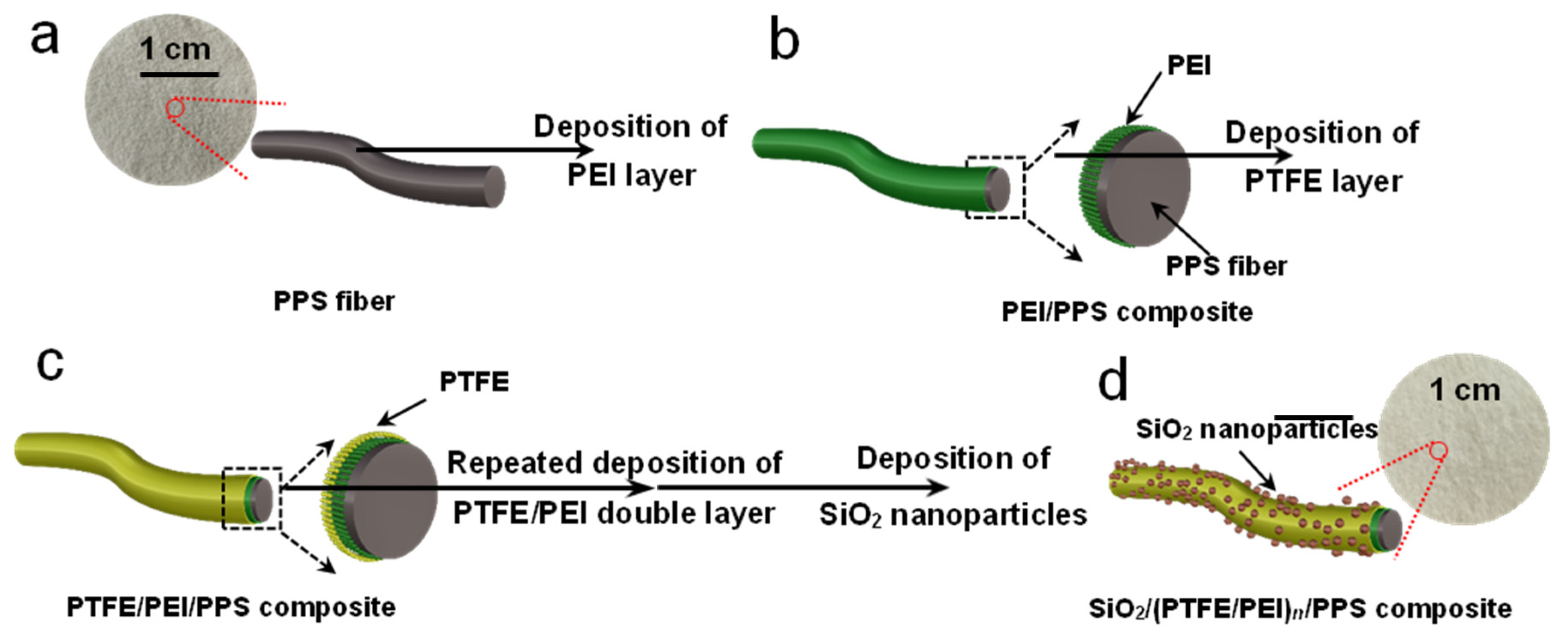
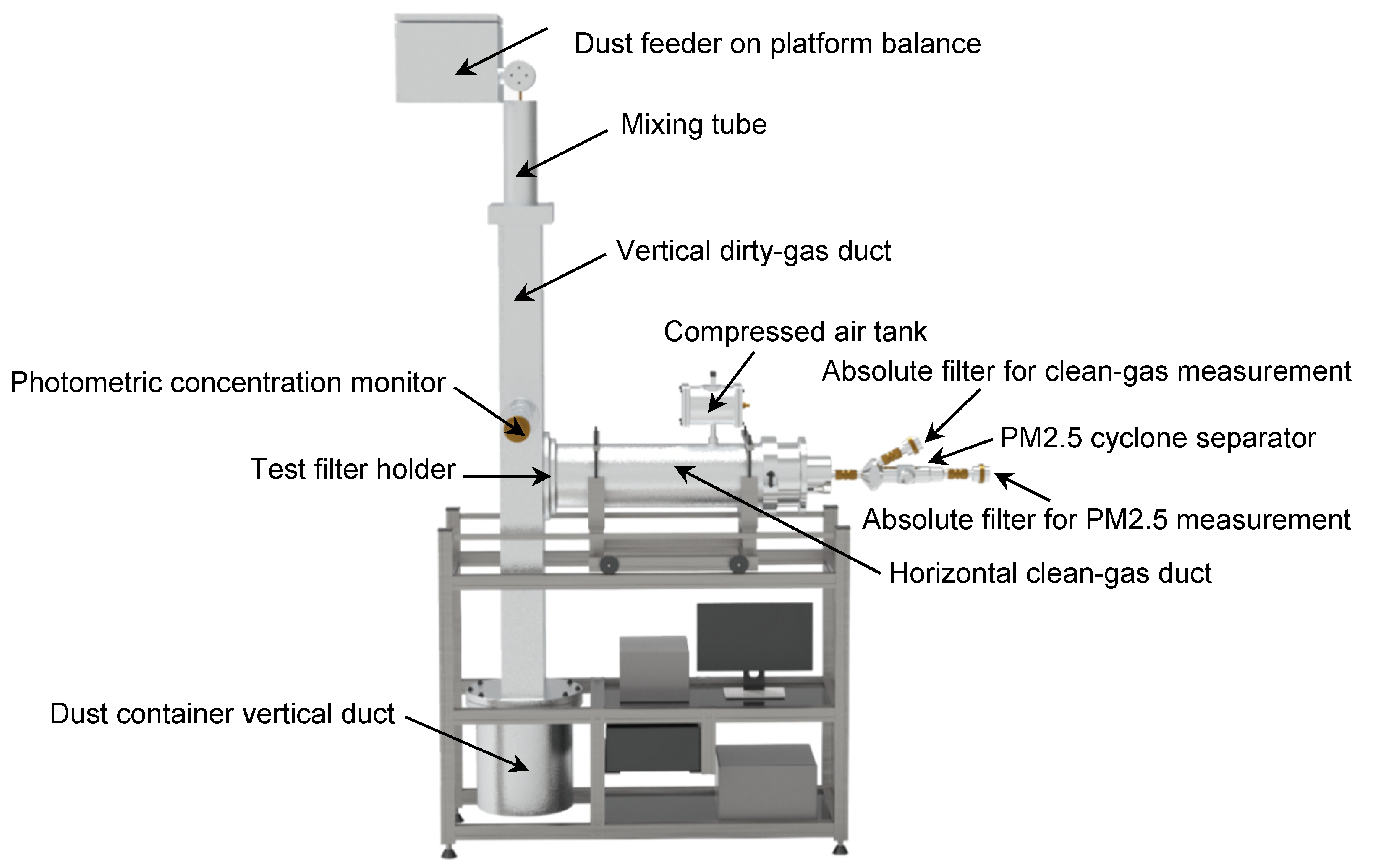

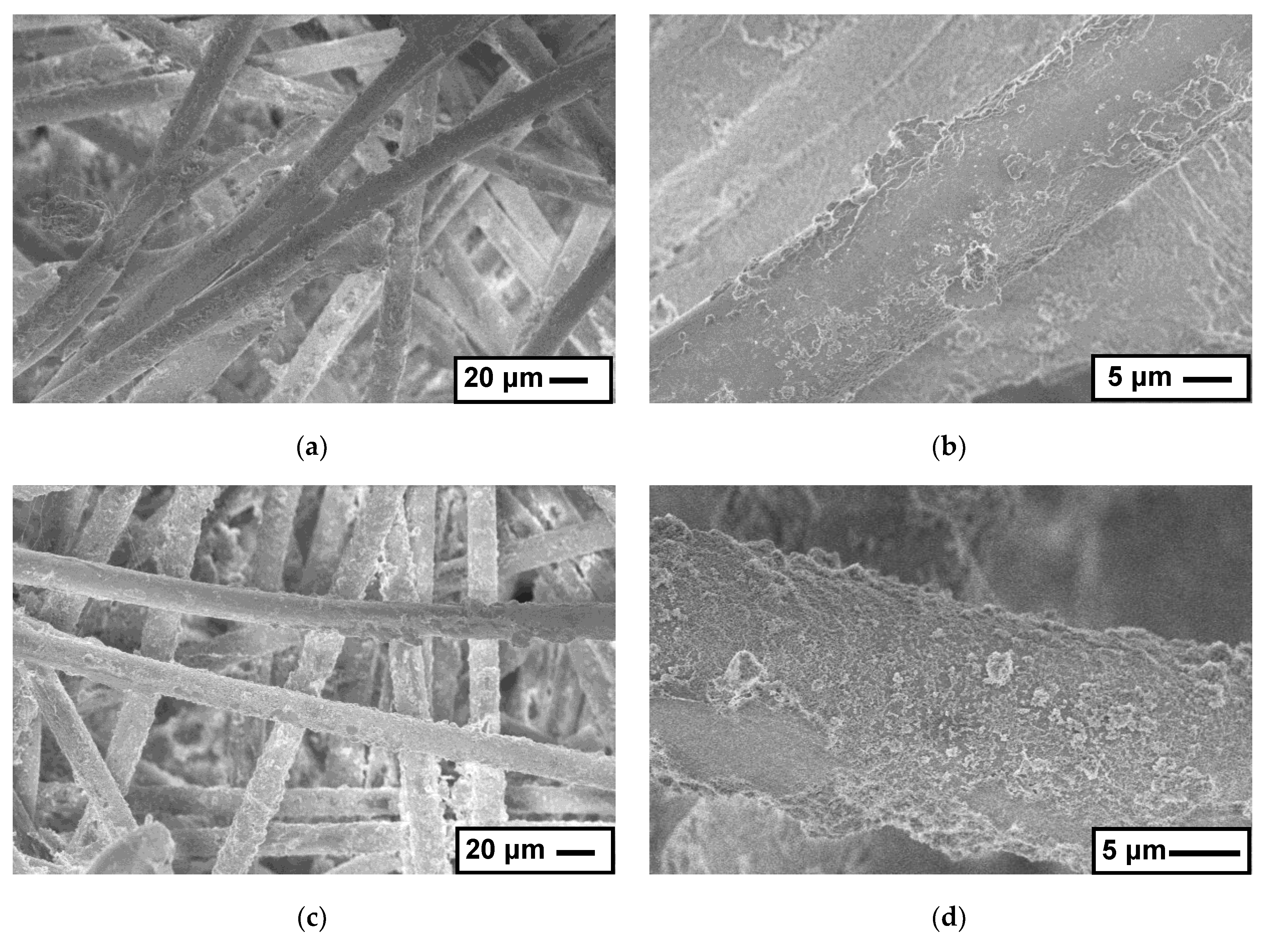
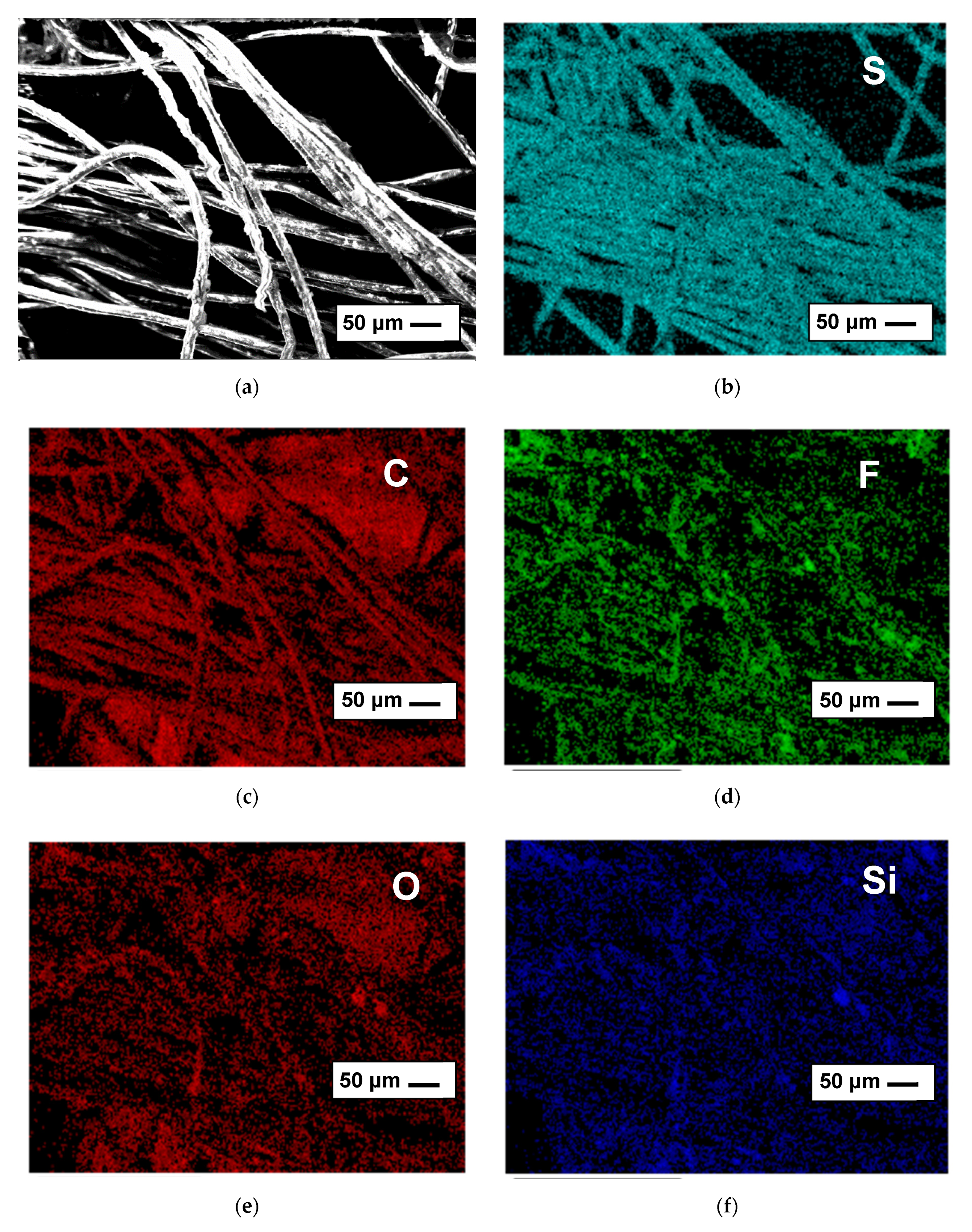
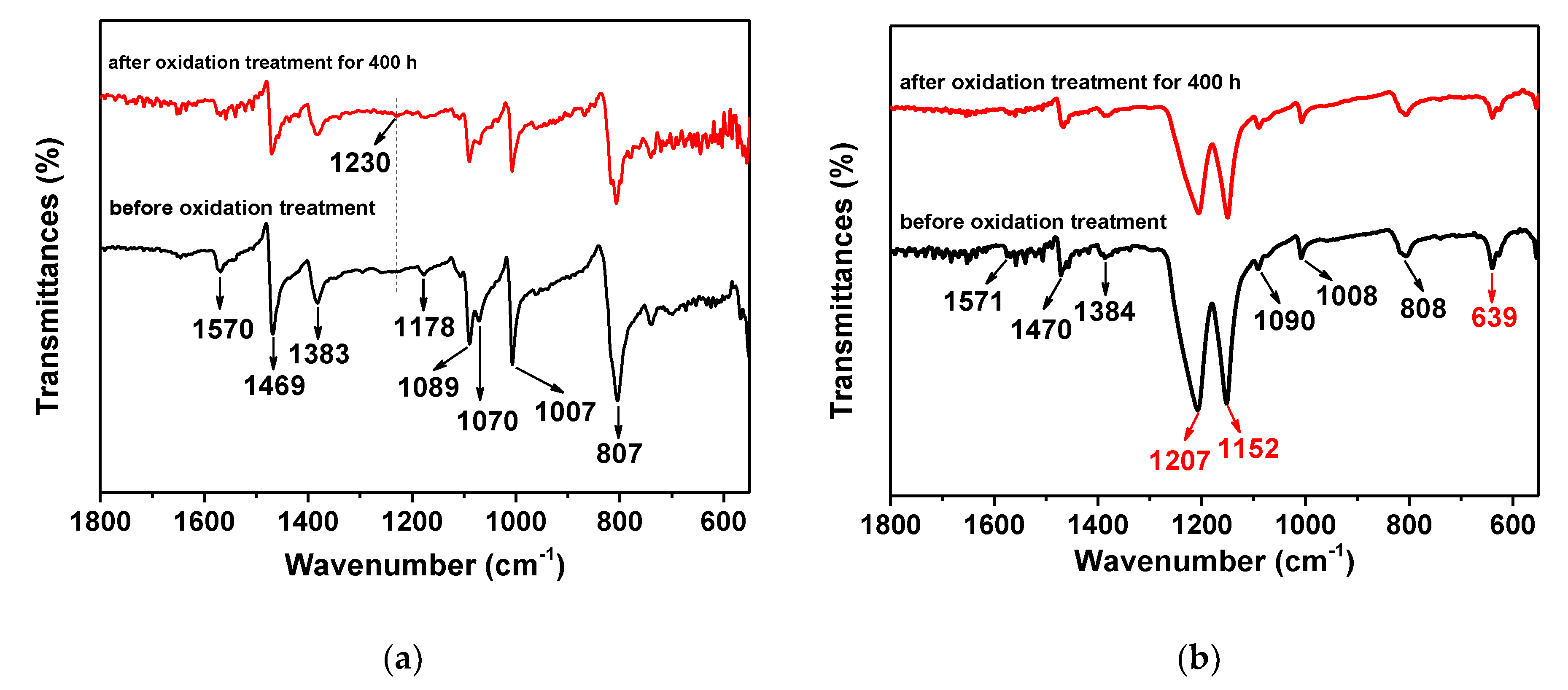
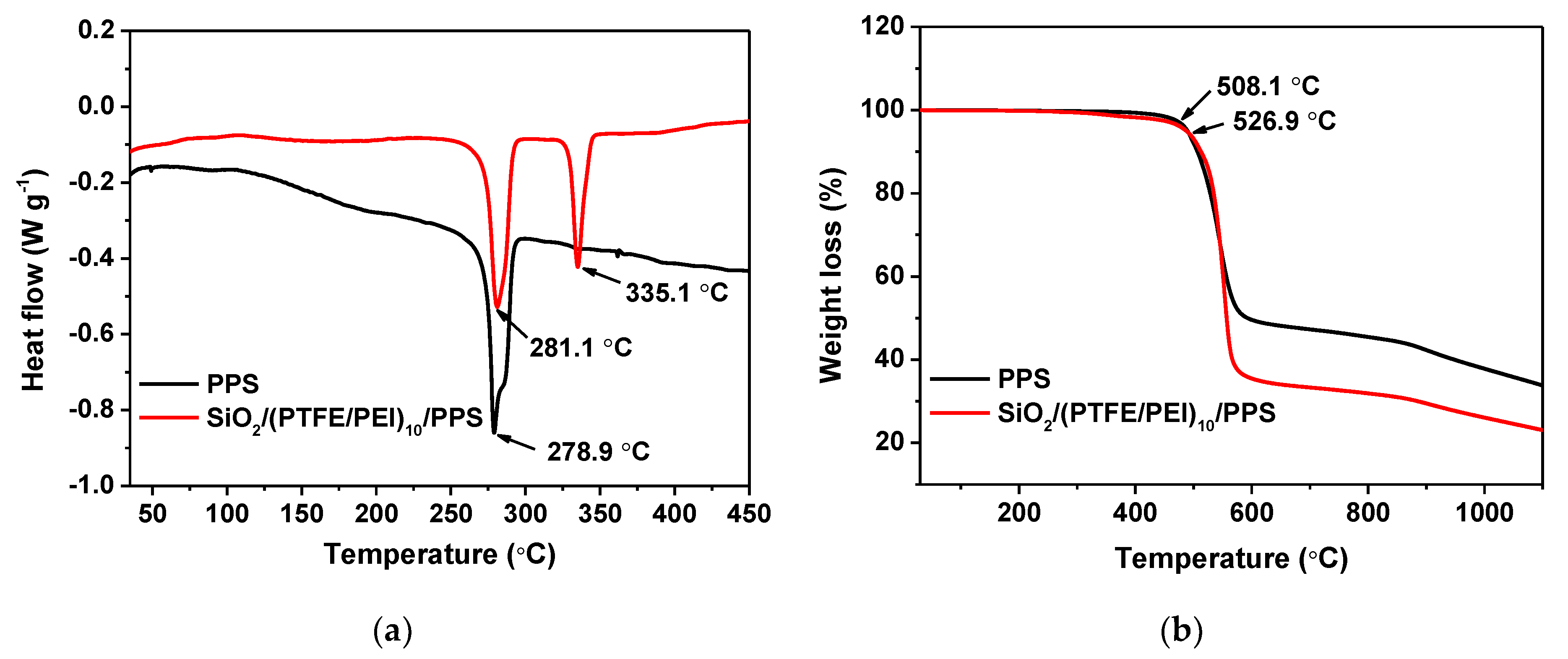
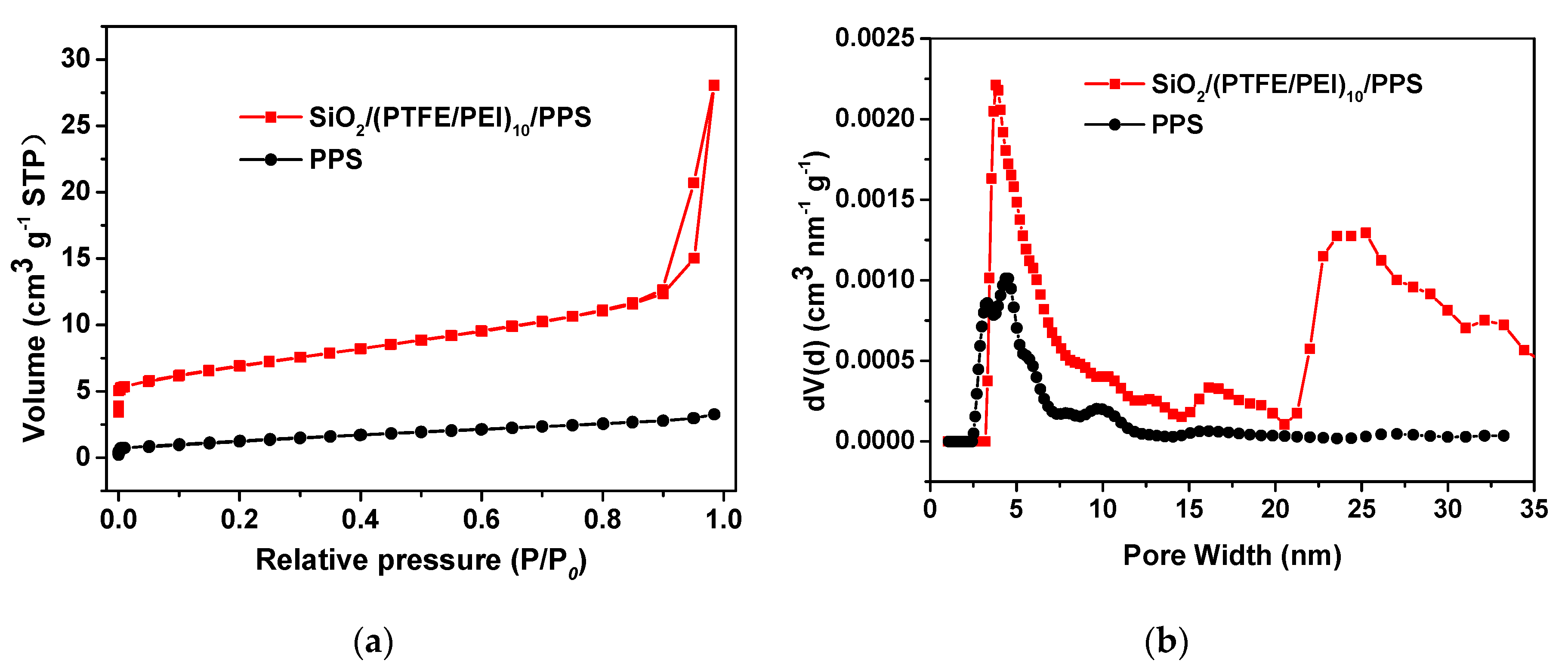
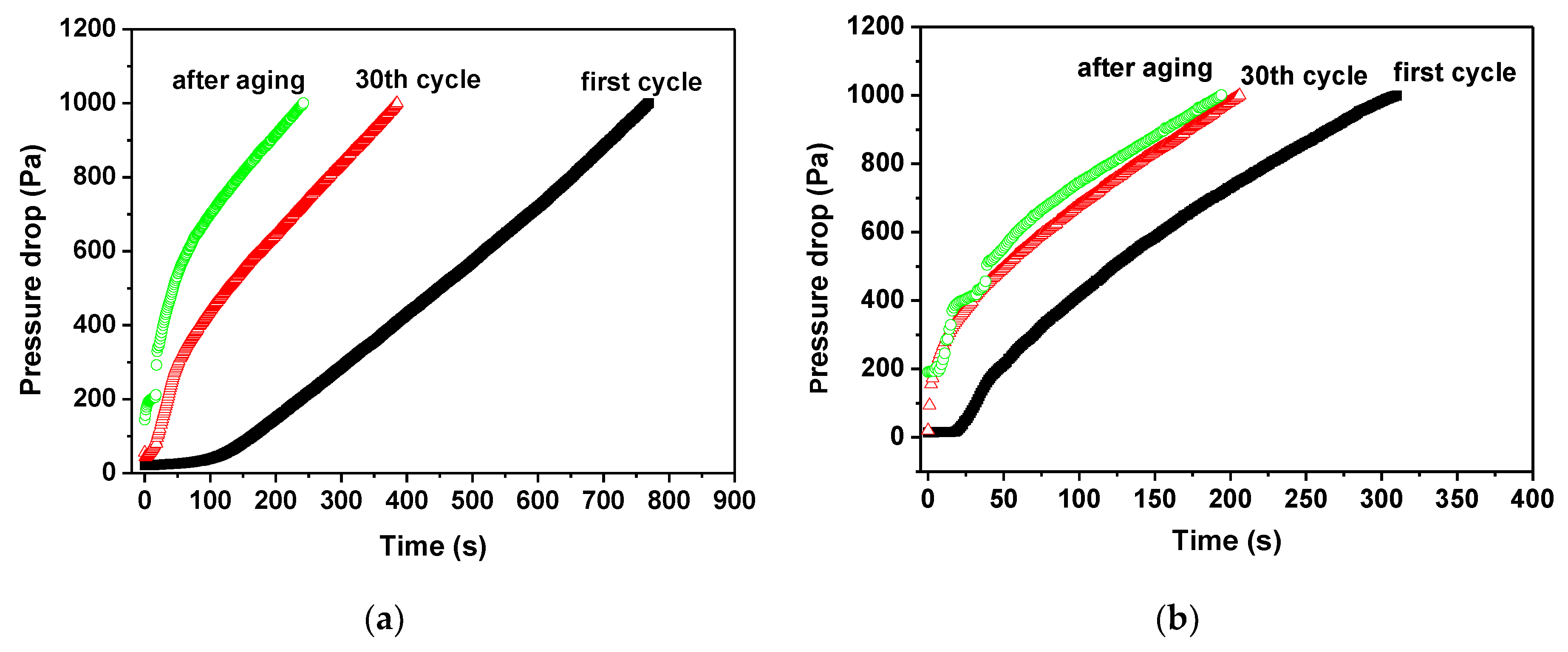

| Filter Media | Meridional Strength (N) | Latitudinal Strength (N) | Air Permeability (L dm−2 min−1) | Wear Resistance (Times) |
|---|---|---|---|---|
| PPS | 1318.9 | 1681.5 | 289.6 | 75 |
| (PTFE/PEI)10PPS | 1413.4 | 1704.7 | 264.2 | 101 |
| SiO2/(PTFE/PEI)10/PPS | 1425.6 | 1753.4 | 259.7 | 125 |
| PTFE membrane-coated PPS | 1434.7 | 1765.3 | 179.7 | 99 |
| Filter Media | The Mass of the Absolute Filter before Measuring (g) | The Mass of the Absolute Filter after Measuring (g) | PM2.5 Emission Concentration (g m−3) | Filtration Efficiency (%) |
|---|---|---|---|---|
| PPS | 0.14435 | 0.55235 | 0.096 | 94.62 |
| SiO2/(PTFE/PEI)10/PPS | 0.14804 | 0.18204 | 0.008 | 99.55 |
Publisher’s Note: MDPI stays neutral with regard to jurisdictional claims in published maps and institutional affiliations. |
© 2021 by the authors. Licensee MDPI, Basel, Switzerland. This article is an open access article distributed under the terms and conditions of the Creative Commons Attribution (CC BY) license (https://creativecommons.org/licenses/by/4.0/).
Share and Cite
Luo, Y.; Shen, Z.; Ma, Z.; Chen, H.; Wang, X.; Luo, M.; Wang, R.; Huang, J. A Cleanable Self-Assembled Nano-SiO2/(PTFE/PEI)n/PPS Composite Filter Medium for High-Efficiency Fine Particulate Filtration. Materials 2021, 14, 7853. https://doi.org/10.3390/ma14247853
Luo Y, Shen Z, Ma Z, Chen H, Wang X, Luo M, Wang R, Huang J. A Cleanable Self-Assembled Nano-SiO2/(PTFE/PEI)n/PPS Composite Filter Medium for High-Efficiency Fine Particulate Filtration. Materials. 2021; 14(24):7853. https://doi.org/10.3390/ma14247853
Chicago/Turabian StyleLuo, Yan, Zhongyun Shen, Zhihao Ma, Hongfeng Chen, Xiaodong Wang, Minger Luo, Ran Wang, and Jianguo Huang. 2021. "A Cleanable Self-Assembled Nano-SiO2/(PTFE/PEI)n/PPS Composite Filter Medium for High-Efficiency Fine Particulate Filtration" Materials 14, no. 24: 7853. https://doi.org/10.3390/ma14247853
APA StyleLuo, Y., Shen, Z., Ma, Z., Chen, H., Wang, X., Luo, M., Wang, R., & Huang, J. (2021). A Cleanable Self-Assembled Nano-SiO2/(PTFE/PEI)n/PPS Composite Filter Medium for High-Efficiency Fine Particulate Filtration. Materials, 14(24), 7853. https://doi.org/10.3390/ma14247853







